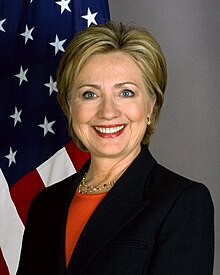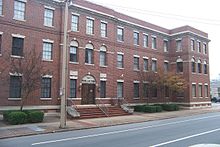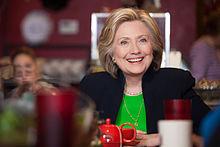Public image of Hillary Clinton

| ||
|---|---|---|
|
First Lady of the United States
U.S. Senator from New York
U.S. Secretary of State
2008 presidential campaign 2016 presidential campaign Organizations
|
||
The cultural and political image of Hillary Clinton has been explored since the early 1990s, when her husband
Subject of writings
Clinton has also been featured in the media and popular culture from a wide spectrum of varying perspectives. In 1995, writer Todd S. Purdum of The New York Times characterized Clinton as a Rorschach test,[4] an assessment echoed at the time by feminist writer and activist Betty Friedan, who said, "Coverage of Hillary Clinton is a massive Rorschach test of the evolution of women in our society."[5] She has been the subject of many satirical impressions on Saturday Night Live, beginning with her time as first lady and has made guest appearances on the show herself, in 2008 and in 2015, to face-off with her doppelgängers.[6][7] Jonathan Mann wrote songs about her, including but not limited to "The Hillary Shimmy Song", which went viral.[8][9][10][11]
Assertions of polarization

Clinton has often been described in the popular media as a
Northern Illinois University political science professor Barbara Burrell's 2000 study found that Clinton's Gallup poll favorability numbers broke sharply along partisan lines throughout her time as first lady, with 70 to 90 percent of Democrats typically viewing her favorably while only 20 to 40 percent of Republicans did.[15] University of Wisconsin–Madison political science professor Charles Franklin analyzed her record of favorable versus unfavorable ratings in public opinion polls and found that there was more variation in them during her first lady years than her Senate years. The Senate years showed favorable ratings around 50 percent and unfavorable ratings in the mid-40 percent range; Franklin noted that, "This sharp split is, of course, one of the more widely remarked aspects of Sen. Clinton's public image."[16] McGill University professor of history Gil Troy titled his 2006 biography of her Hillary Rodham Clinton: Polarizing First Lady and wrote that after the 1992 campaign, Clinton "was a polarizing figure, with 42 percent [of the public] saying she came closer to their values and lifestyle than previous first ladies and 41 percent disagreeing."[17] Troy further wrote that Clinton "has been uniquely controversial and contradictory since she first appeared on the national radar screen in 1992" and that she "has alternately fascinated, bedeviled, bewitched and appalled Americans."[18]
Burrell's study found women consistently rating Clinton more favorably than men by about ten percentage points during her first lady years.

Going into the early stages of her presidential campaign for 2008, a Time magazine cover showed a large picture of her, with two

Once she became Secretary of State, Clinton's image seemed to improve dramatically among the American public and become one of a respected world figure.[37][38] She gained consistently high approval ratings (by 2011, the highest of her career except during the Lewinsky scandal),[39] and her favorable-unfavorable ratings during 2010 and 2011 were the highest of any active, nationally prominent American political figure.[38][40] A 2012 Internet meme, "Texts from Hillary", was based around a photograph of Clinton sitting on a military plane wearing sunglasses and using a mobile phone and imagined the recipients and contents of her text messages. It achieved viral popularity among younger, technically adept followers of politics.[41] Clinton sought to explain her popularity by saying in early 2012, "There's a certain consistency to who I am and what I do and I think people have finally said, 'Well, you know, I kinda get her now.'"[37] She continued to do well in Gallup's most admired man and woman poll and in 2015 she was named the most admired woman by Americans for a record fourteenth straight time and twentieth time overall.[42]
Her favorability ratings dropped, however, after she left office and began to be viewed in the context of partisan politics once more.[43] By September 2015, with her 2016 presidential campaign underway and beset by continued reports regarding her private email usage at the State Department, her ratings had slumped to some of her lowest levels ever.[44] During 2016 she acknowledged that: "I'm not a natural politician, in case you haven't noticed."[45] In July 2017 Bloomberg showed her approval rating at 39 percent.[46]
Public name usage
Several names have been used at various points during Clinton's life, including names preferred by Clinton,[47] names used for her by political opponents, and names used for her by others. Following her birth at Edgewater Hospital in Chicago, Illinois, Clinton was initially named "Hillary Diane Rodham",[47][48] and was generally referred to as "Hillary Rodham". In some formal settings, she used "Hillary D. Rodham", which appeared on her senior thesis,[49] in the transcript of her Wellesley graduation speech,[50] in reports of the United States House of Representatives investigation into the Watergate scandal,[51] and as chair of the Legal Services Corporation.[52] In 1995, Hillary Clinton said her mother had named her after Sir Edmund Hillary, co-first mountaineer to scale Mount Everest, and that was the reason for the less-common "two L's" spelling of her name. However, the first successful Everest climb did not take place until 1953, more than five years after she was born. In October 2006, a Clinton spokeswoman said she was not named after the mountain climber. Instead, this account of her name's origin "was a sweet family story her mother shared to inspire greatness in her daughter, to great results I might add."[53]
Following her marriage to Bill Clinton in 1975, she continued to be known almost exclusively as "Hillary Rodham". Bill Clinton's advisers thought her use of her maiden name to be one of the reasons for his 1980 gubernatorial re-election loss. During the following winter, Vernon Jordan suggested to Hillary Rodham that she start using the name Clinton, and she began to do so publicly with her husband's February 1982 campaign announcement to regain that office. She later wrote that "I learned the hard way that some voters in Arkansas were seriously offended by the fact that I kept my maiden name".[54] Once he was elected again, she made a point of using "Hillary Rodham Clinton" in work she did as First Lady of the state.[55]
As First Lady of the United States
Once she became First Lady of the United States in 1993, she publicly stated that she wanted to be known as "Hillary Rodham Clinton".[56] (This announcement was parodied by the May 1993 film spoof Hot Shots! Part Deux, in which all the female characters were given the middle name "Rodham"; see IMDB entry). As of 1993, she had not legally changed her name from Hillary Rodham.[56] She authored five books and numerous articles as "Hillary Rodham Clinton", interspersed with a smaller number of articles authored as "Hillary Clinton".
During this time, the
Later political career
Clinton continued to use "Hillary Rodham Clinton" on her website and elsewhere once she was a U.S. Senator.[65] When she ran for president during 2007–08, she used the name "Hillary Clinton" or just "Hillary" in campaign materials,[65] and appeared on state ballots as "Hillary Clinton".[47] She used "Hillary Rodham Clinton" again in official materials while serving as United States Secretary of State.[66] In some instances, particularly in email correspondence, Clinton was referred to or signed communications by her initials, HRC.[47][67] As Secretary of State, Clinton used "[email protected]" as her private email address,[68] incorporating her premarital initials.
As of the 2015 launch of her second presidential campaign, she again switched to using "Hillary Clinton" in campaign materials.[66] Clinton's Twitter account notes that tweets "from Hillary" (as opposed to staffers) are signed -H.[69] As of November 30, 2015, both the Associated Press and The New York Times noted that they would no longer use "Rodham" in referring to Clinton, with the AP stating that "the campaign says to go with Hillary Clinton",[70] and The New York Times providing the statement that:
[T]he Clinton campaign confirmed on Monday that Mrs. Clinton prefers to be simply, "Hillary Clinton," aligning herself with the branding of her 2016 presidential campaign and the name she has signed to be placed on the ballots of Iowa, New Hampshire, South Carolina and other states.[71]
The changing usage of Clinton's name has been noted by various observers, and has been related to her political and social role at the time:
[I]t seems that when Clinton feels that a more traditional naming pattern might be a matter of protocol or politically advantageous -- capable of helping her play down the traits for which she is most often criticized -- she is Hillary Clinton. But when Clinton is operating in the private sector or safely ensconced in a public service position where there was no risk of voter backlash, she's Hillary Rodham Clinton.[47]
Political detractors have often referred to Clinton by any of a number of insulting
References
- ^ Smith, Ben (March 12, 2006). "Da Hillary Code". The New York Observer.
- ^ Levy, Clifford J. (October 27, 2000). "Clinton Rivals Raise Little Besides Rage". The New York Times.
- ^ Van Natta, Don Jr. (July 10, 1999). "Hillary Clinton's Campaign Spurs A Wave of G.O.P. Fund-Raising". The New York Times.
- Purdum, Todd S (July 24, 1995). "The First Lady's Newest Role: Newspaper Columnist". The New York Times.
- ^ ISBN 0-19-508940-5.
- ^ Raftery, Liz (April 30, 2015). "Who Did the Best Hillary Clinton Impression on SNL? (Video)". TV Guide.
- ^ Alba, Monica; Sederholm, Jillian (October 4, 2015). "Hillary Clinton Tends Bar, Impersonates Trump in 'SNL' Cameo" (Video)". NBC News.
- ^ "The Hillary Shimmy Song". YouTube. 2016-09-28. Retrieved 2017-09-16.
- ^ "Please Vote For Hillary Even Though You Don't Want To". YouTube. 2016-08-31. Retrieved 2017-09-16.
- ^ "Song A Day: Year Eight | Jonathan Mann". Jonathanmann.bandcamp.com. Retrieved 2017-09-16.
- ^ Johnson, Chris (2016-09-30). "'The Hillary Shimmy Song' explodes on internet". Washingtonblade.com. Retrieved 2017-09-16.
- ^ For sources describing her as a polarizing figure, see Purdum, "The First Lady's Newest Role", op. cit.;
ISBN 0-06-083988-0.
- .
- ^ a b Jacobson, Gary (August 2006). "Partisan Differences in Job Approval Ratings of George W. Bush and U.S. Senators in the States: An Exploration". Proceedings of the Annual Meeting of the American Political Science Association.
- ^ S2CID 143587021.
- ^ Franklin, Charles (January 21, 2007). "Hillary Clinton, Favorable/Unfavorable, 1993–2007". Political Arithmetik. Retrieved January 26, 2008.
- ^ Troy 2006, p. 60.
- ^ Troy 2006, p. 4.
- ^ Data for table is from "Favorability: People in the News: Hillary Clinton". Gallup Organization. 12 October 2007. Retrieved May 22, 2016.. Other polls have shown a similar pattern, see for example Franklin, op. cit.
- ^
- Montopoli, Brian (May 8, 2012). "Hillary Clinton: From divisive to (mostly) beloved". CBS News.
- McCarthy, Justin (June 11, 2014). "Smaller Majority of Americans View Hillary Clinton Favorably". Gallup Organization.
- ^ ISBN 0-7425-2971-1.
- ISBN 978-0-316-01742-8.
- ISBN 978-0-87580-391-3.
- S2CID 144543974.
- ^ "The Presidential Ambitions of Hillary Clinton". Time. August 26, 2006. Retrieved September 27, 2007.
- ^ Hitt, Jack (January–February 2007). "Harpy, Hero, Heretic: Hillary". Mother Jones. Retrieved October 7, 2007.
- Brooks, David (September 25, 2007). "The Center Holds". The New York Times.
- ^ Bartlett, Bruce (May 1, 2007). "Get Ready for Hillary". Creators Syndicate. Archived from the original on May 13, 2007.
- ^ Kirkpatrick, David D. (February 19, 2007). "As Clinton Runs, Some Old Foes Stay on Sideline". The New York Times.
- ^ "Contents: October 22, 2007 Issue". The American Conservative. October 22, 2007. Archived from the original on October 26, 2007. Retrieved October 29, 2007.
- ^ a b "Transcript: December 7, 2007". Bill Moyers Journal. PBS. December 7, 2007.
- ^ Kurtz, Howard (October 3, 2007). "Hillary Chuckles; Pundits Snort". The Washington Post.
- S2CID 153425704.
- ISBN 978-0-252-07511-7.
- ^ Kantor, Jodi (January 10, 2008). "Women's Support for Clinton Rises in Wake of Perceived Sexism". The New York Times.
- ^ a b Meacham, Jon (January 21, 2008). "Letting Hillary Be Hillary". Newsweek.
- ^ a b Combe, Rachael (April 5, 2012). "At the Pinnacle of Hillary Clinton's Career". Elle.
- ^ a b Torregrossa, Luisita Lopez (October 12, 2010). "Hillary Clinton Leads the Pack in Bloomberg Popularity Poll". Politics Daily. Archived from the original on October 14, 2010.
- ^ Saad, Lydia (March 30, 2011). "Hillary Clinton Favorable Near Her All-Time High". Gallup Organization.
- ^ Bailey, Holly (September 16, 2011). "Poll: A third of Americans believe Clinton would've been a better president". Yahoo! News.
- ^ Allen and Parnes 2014, pp. 257–59; Ghattas 2013, plates following p. 150.
- ^ "Clinton Most Admired Woman for Record 20th Time" (Press release). Gallup Organization. December 28, 2015.
- ^ "Barack Obama, Hillary Clinton Extend Run as Most Admired" (Press release). Gallup Organization. December 29, 2014.
- ^ Dugan, Andrew; McCarthy, Justin (September 4, 2015). "Hillary Clinton's Favorable Rating One of Her Worst". Gallup Organization.
- ^ "Hillary Clinton: 'I am not a natural politician'". The Week. March 9, 2016.
- ^ McCormick, John. (July 18, 2017). "Finally, a Poll Trump Will Like: Clinton Is Even More Unpopular". Bloomberg website, Retrieved July 20, 2017.
- ^ a b c d e Janell Ross, "Hillary Clinton will no longer be called 'Rodham.' Here's her complicated history with her maiden name.", The Washington Post (November 30, 2015).
- ^ O'Laughlin, Dania (Summer 2003). "Edgewater Hospital 1929–2001". Edgewater Historical Society. Retrieved June 10, 2007.
- ^ Bill Dedman, "Reading Hillary Rodham's hidden thesis", NBC News (May 9, 2007).
- ^ "Hillary D. Rodham's 1969 Student Commencement Speech", Wellesley College (1969).
- ^ See, e.g., Statement of information submitted on behalf of President Nixon: hearings before the Committee on the Judiciary, House of Representatives, Ninety-third Congress, second session, pursuant to H. Res. 803.
- ^ NLADA Washington Memo, Volume 1 (1972), p. 91.
- ^ "Hillary vs. Hillary". Snopes.com. October 26, 2006.
- ^ Clinton 2003, pp. 91–93; Morris 1996, p. 282.
- ^ Kruse, Michael (April 14, 2015). "The long, hot summer Hillary Clinton became a politician". Politico.
- ^ a b Kelly, Michael (February 14, 1993). "Again: It's Hillary Rodham Clinton. Got That?". The New York Times.
- ^ Michael Kelly, "Hillary Clinton as first lady: a very leading role", Sarasota Herald-Tribune (January 20, 1993), p. 10A.
- ^ Damien Cave, "2005: In a Word; Scalito", The New York Times (December 25, 2005).
- ^ Rush Limbaugh, See, I Told You So (1993), p. 25.
- ^ Rich, Frank (January 27, 2008). "The Billary Road to Republican Victory". The New York Times.
- ^ "Chelsea Clinton Announces Baby No. 2 News on Twitter", Broadway World (December 22, 2015): "Check out the tweet below as well as congratulatory posts from the excited grandparents Bill and Hill!"
- ^ Max J. Rosenthal, "Here's How the US Is Unwittingly Helping to Arm ISIS", Mother Jones (December 11, 2015): "Democrats too. Bill and Hill come to mind".
- ISBN 9780307461353.
- ISBN 1-4013-0004-9.
- ^ a b Williams, Joseph (February 26, 2007). "Name changes define Clinton's various career stages". The Boston Globe.
- ^ a b Elving, Ron (April 13, 2015). "'Hillary Clinton' Is Back, But Will There Be A Return Of The Rodham?". NPR.
- ^ Campbell, Colin (26 May 2015). "Hillary Clinton has an official rap nickname". Business Insider.
Clinton's campaign responded to the segment Tuesday with a nickname of their own, "Run HRC," which is based on the Queens hip-hop group Run DMC
- ^ Reena Flores, "What Hillary Clinton's emails reveal about family aliases and nicknames", CBS News (January 8, 2016).
- ^ Melissa Duko, "Bend It Like Donald: 5 Social Brand Building Lessons", Search Engine People (July 27th, 2016).
- ^ Lauren Easton, "Updating AP style on Hillary Clinton", Associated Press (November 30, 2015).
- ^ Amy Chozick, "Times Drops 'Rodham' in Referring to Hillary Clinton", The New York Times (November 30, 2015).
- ^ Robert E. Denton Jr., Studies of Identity in the 2008 Presidential Campaign (2010), p. 8.
- ^ Rebecca Traister, Big Girls Don't Cry: The Election that Changed Everything (2010), p. 169.
- ^ Brinlee, Morgan (30 October 2016). "'Is Hillary Clinton A Demon' Is A Poll Question Voters Have Actually Been Asked". Bustle.
Over the course of the last 18 months Hillary Clinton has been called a lot of things — crooked, Shillary, Killary, nasty woman, and yes, even the devil.
- Huffington Post.
She's been called 'Shillary,' 'bitch,' and countless other names, yet still, she perseveres.
- ^ Warnica, Richard (9 November 2016). "Why Donald Trump won: In the end, unlike Hillary Clinton, his base showed up — and showed up in force". National Post.
For Election Day, Mark Craig, founder of 'Flint 4 Bernie (Sanders),' had 200 barf bags printed out with the slogan 'I voted 2016.' For months, the former autoworker and Flint, Mich., native had vowed he would never vote for Hillary Clinton. In emails and conversations he calls her 'Shillary' or 'Billary,' or sometimes just 'The Witch.'
Works cited
- ISBN 0-7006-1488-5.


